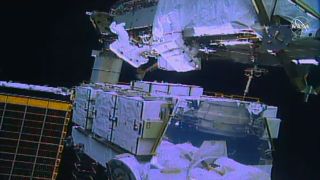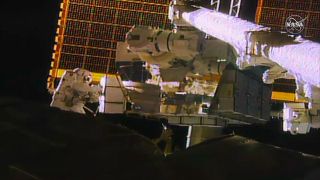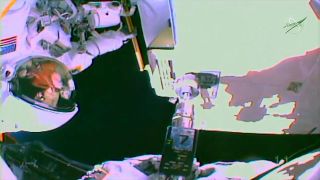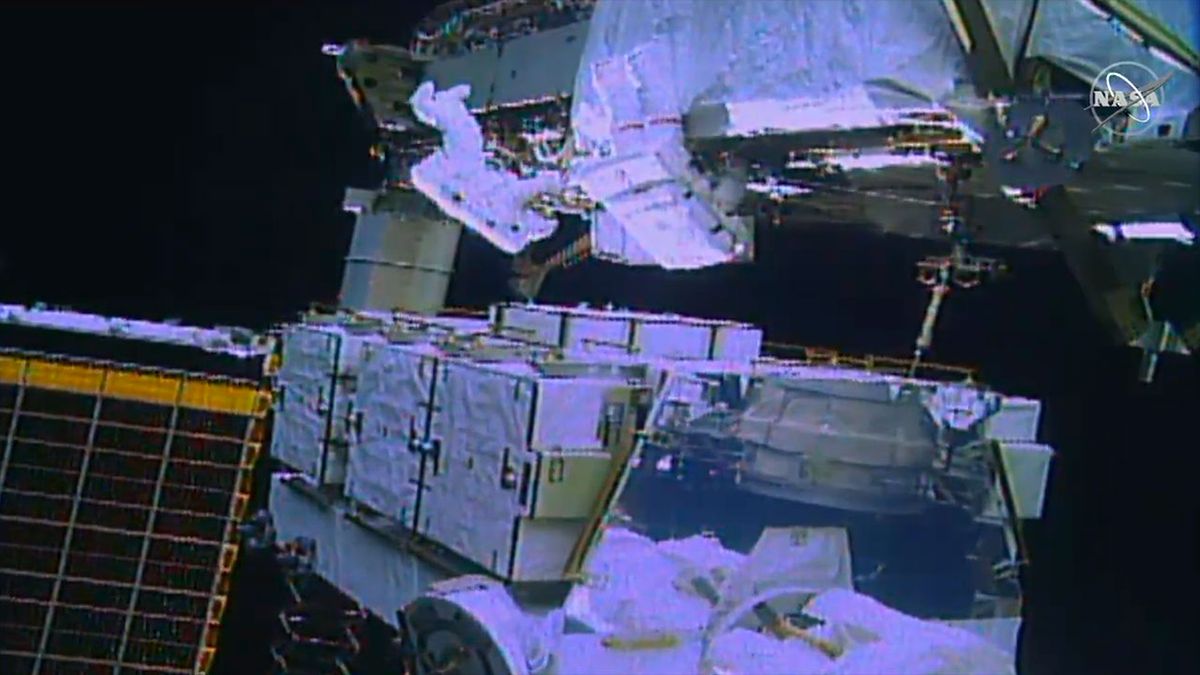HOUSTON — The second all-female spacewalk in history continued the work of the first, as the same two NASA astronauts upgraded batteries outside the International Space Station.
Jessica Meir and Christina Koch completed a 7-hour and 29-minute extravehicular activity (EVA, or spacewalk) on Wednesday (Jan. 15), replacing the batteries that store power for one pair of the space station's electricity-generating solar arrays. The excursion resumed the work that the two Expedition 61 flight engineers performed in October, which made headlines as the first spacewalk by two women.
"It was truly amazing for Christina and me to be back out here today," Meir said during a live broadcast of the spacewalk. "We have been talking about it a lot and it was really something we were looking forward to."
Related: The amazing spacewalks of Expedition 61 in photos
The spacewalk began at 6:35 a.m. EST (1135 GMT), when both Koch and Meir switched their spacesuits over to internal power.
"It's a beautiful view out here," said Meir, soon after exiting the Quest airlock.
The two spacewalkers removed three degraded nickel-hydrogen batteries and installed two more powerful lithium-ion batteries for the space station's port, or left side, outboard solar arrays. Meir and Koch stowed the older batteries, which had been in place for the past decade, on an external pallet for their later disposal and installed adapter plates to enable the new batteries to work with the orbiting laboratory's power system.

"Awesome job," radioed astronaut Stephanie Wilson from inside Mission Control at NASA's Johnson Space Center in Houston, from where she was helping to guide Meir and Koch through the spacewalk's tasks. "We made great progress toward upgrading the batteries on the 4B side. You're both awesome, nice work!"
Each battery measures about half the size of a refrigerator, or 40 inches long by 37 inches wide by 19 inches high (101 by 94 by 48 centimeters). The old nickel-hydrogen batteries weigh 365 lbs. (165 kilograms) each. The lithium-ion replacements weigh 428 lbs. (194 kg).
The work contributed to a larger, ongoing effort to replace all 48 of the station's degraded nickel-hydrogen batteries with the more capable lithium-ion units. One lithium-ion battery and one adapter plate can replace two nickel-hydrogen batteries. The work began with a series of spacewalks in January 2017 and has continued as Japan's H-II Transfer Vehicles (HTVs) have delivered the new batteries to the station.

Meir and Koch's spacewalk on Wednesday proceeded mostly to plan, with the exception of a minor issue with Koch's spacesuit early in the EVA.
"Christina's helmet lights are not attached," radioed Meir to Mission Control, as the assembly normally attached to the top of Koch's spacesuit helmet dangled from its power cable. "The cable is still attached, of course, but the camera and the helmet lights have been detached from her helmet."
Meir attempted to reattach the light assembly, but it would not lock into place. The two lights are used as an aid when the space station passes into Earth's shadow and is not lit by the sun.
"We think with the light locks installed you are not going to be able to get the helmet light seated onto the grooves. So instead, we would like to de-mate the power cable and completely remove the assembly," Wilson told the two spacewalkers.

The spacewalk continued with Koch staying close to Meir so that she was aided by the lights still attached to Meir's helmet.
Wednesday's EVA, which ended at 2:04 p.m. EST (1904 GMT), marked Koch's fifth and Meir's second career spacewalks.
Meir, who served as EV1 (or lead spacewalker) and wore the Extravehicular Mobility Unit (EMU) spacesuit with red stripes, has logged a total of 14 hours and 46 minutes on her two EVAs. Koch, who as EV2 wore the suit with no identifiers, has a total of 35 hours and 17 minutes spanning her five spacewalks.
This was the 225th EVA devoted to the International Space Station since assembly of the orbiting outpost began in 1998.
Meir and Koch are scheduled to again venture outside together on Monday (Jan. 20) to complete the replacement of the batteries on the port P6 truss.
- FAQ: How do astronauts take spacewalks?
- NASA astronauts recount epic all-woman spacewalk in Washington Post op-ed
- Trump hails NASA astronauts on 1st all-woman spacewalk in history
Robert Pearlman is a Space.com contributing writer and the editor of collectSPACE.com, a Space.com partner site and the leading space history news publication. Follow collectSPACE on Facebook and on Twitter at @collectSPACE. Follow us @Spacedotcom and Facebook.

